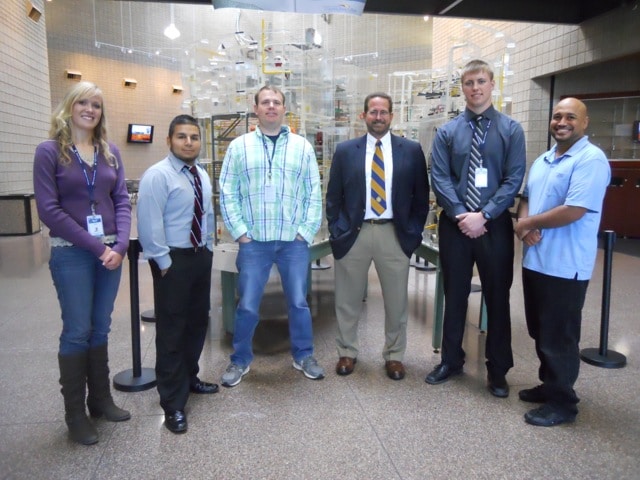Terrestrial Energy Announces Plans To License Their Integral Molten Reactor In The U.S.
Yesterday, Terrestrial Energy USA (TEUSA) informed the U.S. Nuclear Regulatory Commission (NRC) that they planned to begin pre-license application discussions with a goal of being ready to file a design certification application no later than Oct 2019.
Here is a brief video that provides an overview of Terrestrial Energy‘s Integral Molten Salt Reactor (IMSRTM
TEUSA filed a 7 page letter with the NRC that provides a detailed response to the NRC’s request (in RIC 2016-08) that companies with plans to request NRC regulatory services in fiscal year 2019 provide sufficient details about their plans to allow the agency to produce its budget for that year.
Quoting from TEUSA’s press release:
TEUSA recognizes that the USNRC is developing a specific licensing framework for Advanced Reactor designs. The Company has confidence in the capability of the USNRC to review and reach safety, security, and environmental findings on the IMSR™ design, in a timely manner.
Simon Irish, CEO of TEUSA commented, “This is a very exciting time for the nuclear power industry. We are moving forward with the design and regulatory actions needed to allow the Company to bring the IMSR™ to market in the 2020s. The IMSR™’s design choices will result in an Advanced Reactor that delivers clean, cost-competitive and high-grade industrial heat. This capability can serve the many and varied heat requirements of industry, and as well as those of the electric power sector where the IMSR™’s dispatchablity will be greatly prized.”
The Company is currently examining four sites for its first commercial plant. These sites include the Idaho National Laboratory (INL), near Idaho Falls, ID, as well as additional sites east of the Mississippi River. In all cases, TEUSA has begun to investigate the commercial prospects for an IMSR™ power plant for both electric-power and industrial heat co-generation.
Of course, it wouldn’t be very strategic for a company that is already engaged in a lengthy and expensive regulatory process to publicly criticize the agency whose approval they will need in order to begin obtaining a return on their massive investment of private capital.
That caution doesn’t apply to a pestering blogger who doesn’t need the NRC’s permission to continue publishing.
Though I, like TEUSA, have confidence that the NRC has the capability to prepare and to be ready to properly evaluate the IMSRTM, I think it is important to add a critical caveat. The NRC isn’t ready today and will not be ready in FY2019 unless they promptly receive the proper direction and resources from Congress to become ready.
If the NRC does not make the investment now, or within a very short period of time, they will not have the expertise to independently and properly evaluate TEUSA’s innovative, but simple and evolutionary design. There are experts, documents and other resource materials available to support the learning processes, but humans are not Vulcans. It will take time and focus to enable the talented people at the NRC to become molten salt reactor experts.
TEUSA isn’t the only company that is pursuing this kind of technology; the investment in the capability to properly understand and review liquid fueled, molten salt cooled reactors is not promotional or “picking winners” in any way.
TEUSA’s announcement also offers a tiny window into the NRC’s current regulatory paradigm.
Reading Regulatory Issue Summary (RIS) 2016-08 and Terrestrial Energy’s response helps to provide support for the frustration that is often expressed here with the NRC’s processes as developed over the decades. Those legacy processes have evolved with heavy influence from legislators, established companies and intensely active opponents.
These documents are just one of many such interactions that will be taking place during the next 5-8 years before the design certification is complete.
Nothing moves quickly in the nuclear energy area, but there are ways to help speed the processes and lower the costs for everyone.
Note: I should have checked my in-box to see TEUSA press release before republishing NRC Vision And Strategy For Licensing Advanced Reactors Needs Improvement without modifying it to acknowledge TEUSA’s announced plan. That plan makes the following statement obsolete.
Not surprisingly, none of the 50 companies that are working on advanced reactors in the U.S. have announced any plans to apply to the NRC for permission to build their designs in the U.S.



This is truly excellent news. Please correct me if I am wrong, but I thought that Terrestrial was planning on licensing in Canada instead of the US. If that is true, what changed?
@RTK42C
Terrestrial Energy is pursuing licensing in both the USA and Canada.
I would hope that both the Canadian and US regulatory agencies would take the licensing as a challenge to see who can “get there” with the best and the fastest licensing review.
Perhaps this is too much to wish for, but I see an opportunity for the two agencies to cooperate so that both don’t need to invent the whole licensing process for this new type of reactor from scratch.
Rod – thanks! This is indeed great news. Hopefully the new administration in the USA will decide they don’t want to miss commercial opportunities for new US nuclear technology companies. We need all the various designs working and competing around the world.
Rod:
Do you not consider NuScale to be an advanced reactor? I ask, because they *also* just announced that they were applying with NRC:
http://newsroom.nuscalepower.com/press-release/company/nuscale-submits-first-ever-small-modular-reactor-design-certification-applicat
James Conca over at Forbes wrote about it the other day:
https://www.forbes.com/sites/jamesconca/2017/01/15/nuscale-first-to-submit-smr-nuclear-application-to-nrc/#704cf535581e
@Jeff S
NuScale Power Modules are definitely advanced, modern designs. I should have been more careful to insert the adjective of “non-LWR” in front of advanced.
You’re correct NuScale intends to license their reactor with the NRC. Not only have they already spend more than $11 million paying for 43,000 hours of NRC professional staff time, but they have actually completed their license application and submitted it to the NRC.
Toshiba to quit the nuclear construction industry:
http://newsonjapan.com/html/newsdesk/article/118856.php
Does this mean that Westinghouse won’t be building any more AP1000s?
@David B. Benson
Please see my piece on Forbes.com Toshiba Likely To Exit Nuclear Plant Construction Business.
I read it. Thank you.
“The NRC isn’t ready today and will not be ready in FY2019 unless they promptly receive the proper direction and resources from Congress to become ready”
Yes with direction from Congress the NRC could theoretically extend itself to train up for MSR designs. But institutionally, do the people there want to allow this to happen? Both the NRC staff and the existing commercial industry is light-water through and through. In DoE/NRC testimony in 2014, Peter Lyons as much as told non light-water designs to go play in the grant box, as nothing but light water would be deployed in the near future in the United States.
Yes Congress could act, should act. What should we expect of politicians however if stories begin leaking FUD from unamed scientists in DoE claiming that MSR vessels will, say, somehow mysteriously corrode away, and need just as much containment (read dollars) as 150 bar light water?
When I questioned the safety of using molten salt fueled reactors for sea vessel propulsion, Terrestrial Energy banned me from accessing their twitter account.
All I did was point out that salts dissolve more readily in water than ceramic pellets 🙁
The melting temperature of ceramics is around 1400 C., whereas salt is around 800. Below that point it freezes, presumably in a containment vessel. So what was your point exactly?
Salts dissolve in water, whereas pellets don’t. Obvious really.
@benjamin weenen
I’ll let molten salt experts respond, but I hope you realize that the salts proposed for liquid fuel reactors are NOT NaCl (table salt).
I don’t know what their solubility properties are, but it’s a pretty good assumption that they are different from the familiar NaCl.
Yes I realise fluorides do not dissolve as readily as chlorides. But dissolve they do. And sodium chloride is indeed the main fuel salt for the Moltex proposal I believe.
I’m not expert. I just opined sea vessels probably weren’t the best place to site a salt fueled nuclear reactor. No criticism of Terrestrial Energy, of whom I’ve been a fanboy of since its inception.
Just odd how they were so touchy on the subject of how water and fuel salts might not be a match made in heaven.